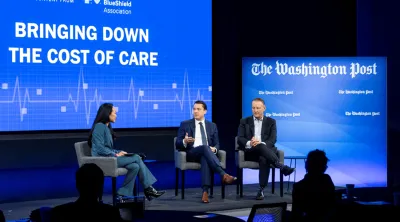
Author: Sean Robbins
America has a health care affordability problem—one that is affecting every corner of our economy and the well-being of our families, friends, colleagues and communities. For too long, the health care system has been trying to fix high costs by shifting them around. It’s time for all health care stakeholders to work together with business and government to attack the root of the problem.
Recently, I joined a Washington Post Live panel with Shawn Martin, executive vice president and chief executive officer of the American Academy of Family Physicians, where we discussed the affordability problem and how to find common-ground solutions.
The Problem
Half of Americans report that it is difficult to afford care, and, as Martin explained, this takes a toll on patients’ health. Many do not seek out preventive care, like mammograms and colonoscopies. Additionally, one in three Americans aren’t taking prescription drugs as needed because of cost. These are just two examples of why it is essential to partner with primary care doctors to reimagine a system that prioritizes preventive care and early intervention instead of, as Martin outlined, focusing on expensive interventions that add more cost to the system.
In addition, business leaders are increasingly concerned about their ability to remain competitive as health care costs continue to rise. Forty-nine percent of Americans get their insurance coverage through their employers, and as employers are forced to spend more on health care, they are forced to cut critical investments in research and development and wages. When employers aren’t able to reinvest in their businesses, it jeopardizes America’s long-term economic growth and global competitiveness.
Implementing Site-Neutral Payments
Although addressing the rising cost of health care is complicated, there are commonsense steps we can take. For instance, we’ve seen a trend of independent physicians being purchased by corporate hospital systems. Often after the hospital takes control, what was once a doctor’s office is now called a hospital outpatient center. And with the name change, the hospital can charge higher rates. Patients can receive the same care in the same room from the same doctor—but at much higher prices, in some cases more than twice as much. The location where a patient gets a procedure should not increase the cost of the procedure. If we close this loophole, we could remove nearly $500 billion over 10 years from the health care system.
Increasing Competition for Prescription Drugs
Prescription drugs also continue to drive spending—especially when it comes to brand name specialty drugs. We have to increase competition and bring affordable generics to the market faster. The Blues are striving to change this through our investment in Civica Rx—which will bring generic drugs directly to consumers at the lowest possible price. By directly handling the manufacturing and distribution, we’re able to eliminate the intermediaries and inflated costs that have plagued the market and forced consumers to pay artificially high prices for generic drugs. Through this approach, we will disrupt the supply chain and bring $30 insulin to the market for patients around the country.
I believe we can come together and find solutions that won’t force patients to choose between accessing the care they need or paying for essentials like food and housing. We need to change the conversation to put the people that we serve in the middle of the conversation and come to the table with new ideas. I’m confident that, together, we can help make Americans healthier, businesses stronger and the country’s economy more competitive.

